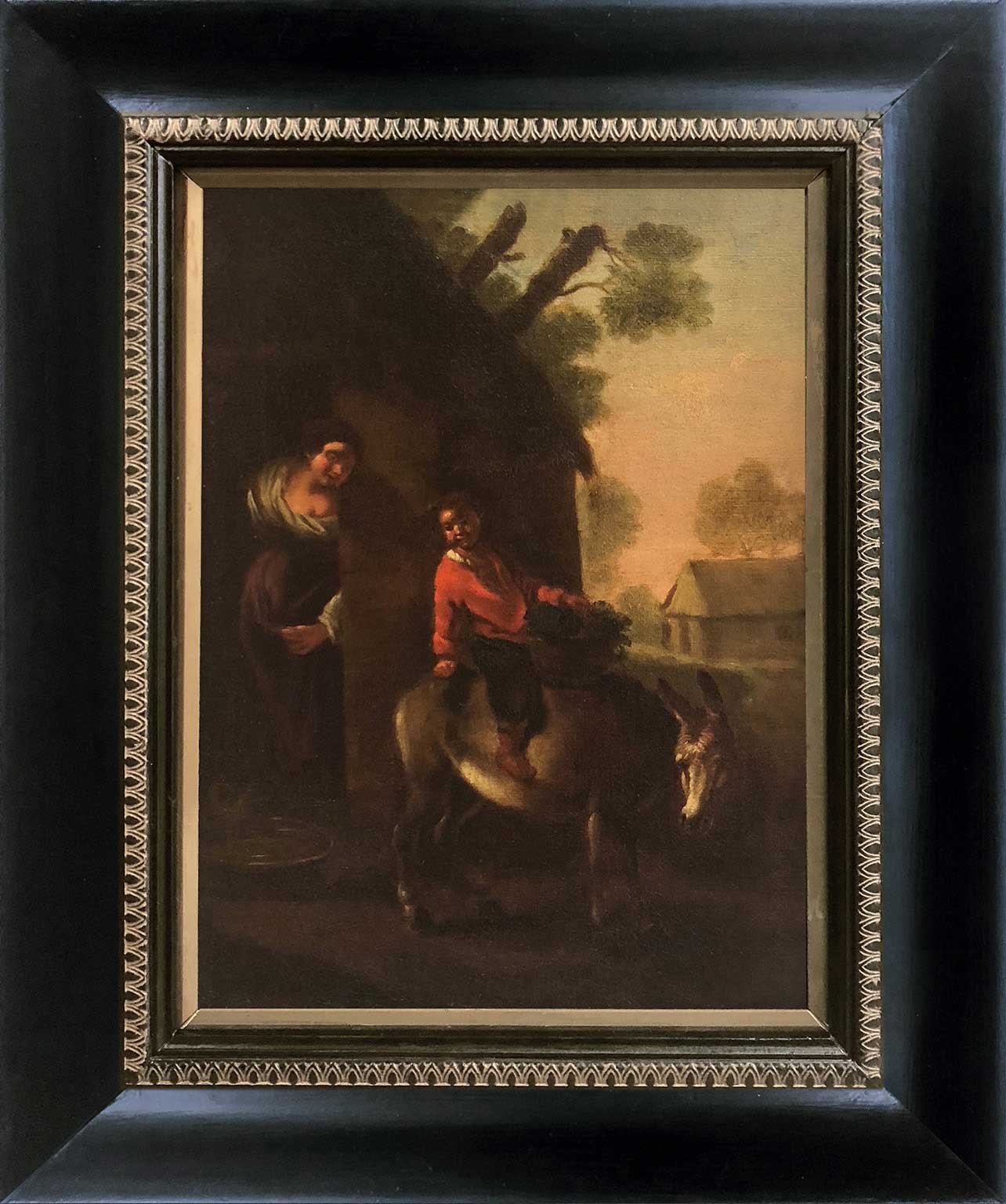 Image 1 of 2
Image 1 of 2

 Image 2 of 2
Image 2 of 2



Flemish School 17th Century
Artist: Flemish School 17th Century.
Title: Boy on Donkey.
Medium: Oil on canvas.
Framed Size: Height 48.5 cm x Width 39.5 cm x Depth 2 cm.
Image Size: Height 33.5 cm x Width 24.5 cm.
Condition: Recently cleaned and varnished, the painting has a canvas repair with minor retouching, previous relining of canvas undertaken with conservator stamp verso (likely conserved in Europe). The condition of the work is good, with wear commensurate with age.
Provenance: Private Collection Sydney Australia.
The Collection of Lajos Ernst (1811-1937) according to Ernst Museum label verso. This label most likely corresponds to an Ernst stock auction in 1939. Chalk markings verso are illegible. The frame is 19th Century and not original to the piece although complimentary in period style.
About: A genre work dating likely to the early 17th century, it is quintessential to the period in terms of subject and palette. The piece draws parallels from artists of the period including Jan Miel and Pieter van Laer and several others of the Roman Bamboccianti school of painters. The subdued colours and the sense of naivety directed toward the figures' anatomy are consistent qualities found in many of the works that explore the issues of social status, poverty and vice throughout 17th-century Flanders. The work is unsigned however the piece may have lost some dimension in the relining process.
Artist: Flemish School 17th Century.
Title: Boy on Donkey.
Medium: Oil on canvas.
Framed Size: Height 48.5 cm x Width 39.5 cm x Depth 2 cm.
Image Size: Height 33.5 cm x Width 24.5 cm.
Condition: Recently cleaned and varnished, the painting has a canvas repair with minor retouching, previous relining of canvas undertaken with conservator stamp verso (likely conserved in Europe). The condition of the work is good, with wear commensurate with age.
Provenance: Private Collection Sydney Australia.
The Collection of Lajos Ernst (1811-1937) according to Ernst Museum label verso. This label most likely corresponds to an Ernst stock auction in 1939. Chalk markings verso are illegible. The frame is 19th Century and not original to the piece although complimentary in period style.
About: A genre work dating likely to the early 17th century, it is quintessential to the period in terms of subject and palette. The piece draws parallels from artists of the period including Jan Miel and Pieter van Laer and several others of the Roman Bamboccianti school of painters. The subdued colours and the sense of naivety directed toward the figures' anatomy are consistent qualities found in many of the works that explore the issues of social status, poverty and vice throughout 17th-century Flanders. The work is unsigned however the piece may have lost some dimension in the relining process.
Artist: Flemish School 17th Century.
Title: Boy on Donkey.
Medium: Oil on canvas.
Framed Size: Height 48.5 cm x Width 39.5 cm x Depth 2 cm.
Image Size: Height 33.5 cm x Width 24.5 cm.
Condition: Recently cleaned and varnished, the painting has a canvas repair with minor retouching, previous relining of canvas undertaken with conservator stamp verso (likely conserved in Europe). The condition of the work is good, with wear commensurate with age.
Provenance: Private Collection Sydney Australia.
The Collection of Lajos Ernst (1811-1937) according to Ernst Museum label verso. This label most likely corresponds to an Ernst stock auction in 1939. Chalk markings verso are illegible. The frame is 19th Century and not original to the piece although complimentary in period style.
About: A genre work dating likely to the early 17th century, it is quintessential to the period in terms of subject and palette. The piece draws parallels from artists of the period including Jan Miel and Pieter van Laer and several others of the Roman Bamboccianti school of painters. The subdued colours and the sense of naivety directed toward the figures' anatomy are consistent qualities found in many of the works that explore the issues of social status, poverty and vice throughout 17th-century Flanders. The work is unsigned however the piece may have lost some dimension in the relining process.